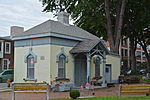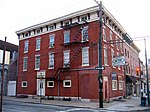Brownhill & Kramer Hosiery Mill
Commercial buildings on the National Register of Historic Places in PhiladelphiaPhiladelphia County, Pennsylvania Registered Historic Place stubs

The Brownhill & Kramer Hosiery Mill is a historic building complex in the Fishtown neighborhood of Philadelphia, Pennsylvania. It was listed on the National Register of Historic Places in 2014. The buildings are currently known as The Chesterman and has been rehabbed into rental apartments units.
Excerpt from the Wikipedia article Brownhill & Kramer Hosiery Mill (License: CC BY-SA 3.0, Authors, Images).Brownhill & Kramer Hosiery Mill
Memphis Street, Philadelphia
Geographical coordinates (GPS) Address Nearby Places Show on map
Geographical coordinates (GPS)
| Latitude | Longitude |
|---|---|
| N 39.974166666667 ° | E -75.132222222222 ° |
Address
Memphis Street 469
19125 Philadelphia
Pennsylvania, United States
Open on Google Maps









